12 Health Benefits of Eka Pada Rajakapotasana & How to Do It?
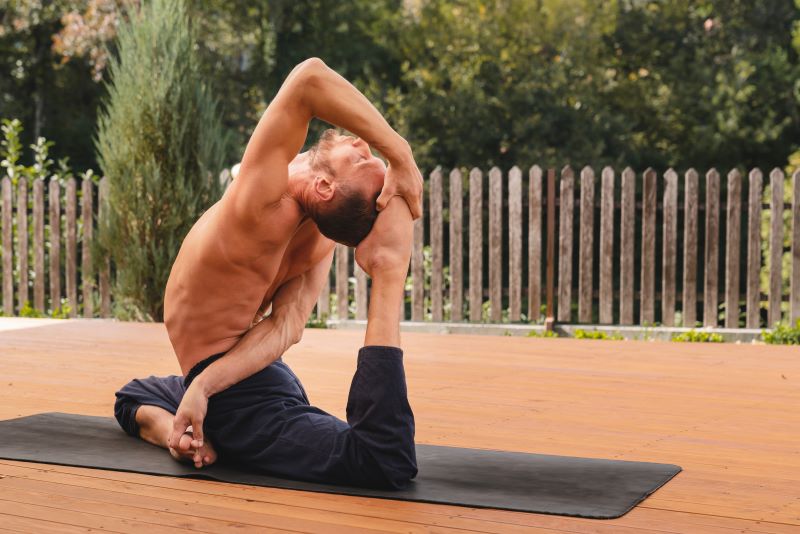
Indian yoga has played a significant role in health and wellness for ages. However, due to the modern lifestyle, working personnel sit at a desk and work for long hours. This practice tends to tighten our hips and cause numerous other health complications.
Eka Pada Rajakapotasana, also known as Kapotasana, is a yoga pose that can be tried at home to eliminate such health complications. One of the essential benefits of Pigeon Pose is that it's a highly effective hip opener.
Read the full article to learn about its other health benefits, precautions, and more.

Table of Contents

What is Eka Pada Rajakapotasana?
Eka Pada Rajakapotasana, or Pigeon Pose, is a deep backbend pose performed in a seated position that helps open the hip and relieve lower back pain. It also improves flexibility.
This name has been kept because, in the final pose, the practitioner puffs up their chest, which resembles the shape of a pigeon. If we try to find out the meaning of the name Eka Pada Rajakapotasana, we can break it into:
Eka meaning one
Pada meaning leg
Raja meaning king
Kapota meaning pigeon
In addition, Pigeon Pose increases the external rotation of the femur bone in the hip socket and lengthens the psoas muscle that connects the torso and legs. If you are interested in learning about the benefits of Pigeon Pose, refer to the list provided below.
How to Perform Eka Pada Rajakapotasana (Pigeon Pose)?
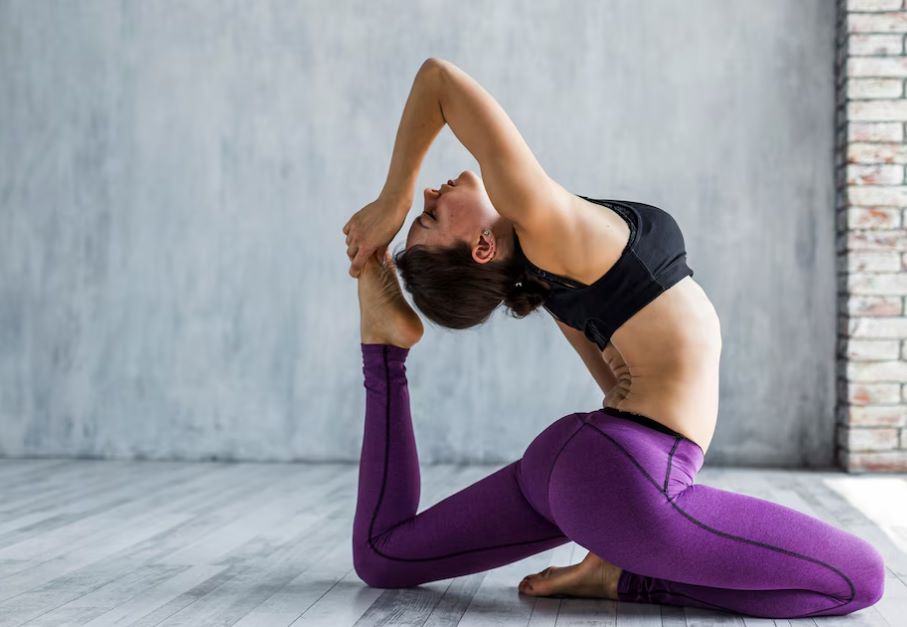
Provided below is a step-by-step guide as to how you can perform the Eka Pada Rajakapotasana, i.e., Pigeon Pose:
Step 1: Start with the downward-facing dog pose, then bring your right leg up into a downward dog split posture.
Step 2: Bend your right knee and bring your leg forward like you would step into a lunge. Bring your right knee to the floor outside of your right hand. Keep the right shin parallel to the front of your mat or angled back towards the left hip according to your range of motion.
Step 3: Release your left knee to the mat and see that it is flat on the floor. Confirm it by looking back to see that it is pointing straight back.
Step 4: Towards the front of your mat, square your hips. If you are not comfortable, you can support yourself with a folded blanket by placing it under the right side of your hip.
Step 5: When you are stable, put your torso forward over your right leg.
Step 6: Balance your weight and keep your hips square as best you can. You can use a blanket or block to help you stay balanced. Try touching your forehead towards the floor.
Step 7: Keep your hips squared up and breathe.
Step 8: Come back and keep your hands in line with your hip.
Step 9: To release, get back into the downward dog pose by curling your left toes slowly.
Step 10: Repeat this pose on the other side with your right toe.
12 Health Benefits of Eka Pada Rajakapotasana
There are a large number of benefits that we can get from performing this yoga. Some of the benefits of Eka Pada Rajakapotasana are:
1. Reduces Lower Back Pain
This yoga pose strengthens your back and spine. An overall stretch of the body helps reduce lower back pain. It also increases the body's mobility and helps activate the muscles in the lower back.
2. Opens Up Hips
One of the most essential benefits of Pigeon Pose is that it effectively opens the hip. Stretching your thighs, back, groin, piriformis, and psoas helps open the hip. This, in turn, improves blood flow and helps prevent pain or stiffness.
3. Improves Posture
By strengthening the core and back muscles, Eka Pada Rajakapotasana helps improve posture. Proper alignment of the spine is promoted, which is beneficial for overall body mechanics. Improved posture can reduce the risk of back and neck pain.
4. Strengthens Back, Abdomen, Hips and Legs
This yoga pose puts extra pressure on the back, abdomen, hips, and legs, increasing blood flow in these muscles. This, in turn, helps the muscles get more nutrition and oxygen, which aids in strengthening. Practising this asana daily will help prevent back, abdomen, hip, and leg injuries while exercising or doing other work.
5. Strengthens Neck, Chest and Shoulder
Rajakapotasana stretches the neck, shoulder, and chest muscles, which helps improve the area's blood flow. In addition, it helps strengthen and tone the muscles. Regular practice will reduce shoulder and arm pain while also strengthening the bones.
6. Improves Digestion
If practised daily, Rajakapotasana improves digestive health. It prevents digestion-related issues like constipation and helps create stress hormones that promote the digestive system's functioning. In addition, it improves proper bowel movement and supports the production of digestive juices and enzymes that help in proper digestion.
7. Improves Flexibility of Spine
Daily practice of Rajakapotasana will improve the spine's flexibility and help keep it strong and straight. In addition, as the spine is a little bit backward while doing this posture, it reduces the hunch and improves the spine's elasticity. As a result, it reduces back pain and stiffness.
8. Improves Functioning of Kidneys and Liver
Regularly practising Rajakapotasana helps stimulate liver and kidney health. This is because while doing the asana, a lot of pressure is created on the kidneys and liver, producing stress hormones and helping them function better.
9. Improves Circulation
The deep stretch in this pose improves blood flow to the pelvic region and lower extremities. Better circulation helps nourish the tissues and promote overall health. Enhanced blood flow can also lead to improved energy and vitality
10. Increases Energy Levels
Regular practice of this pose helps in boosting vitality and energy levels. The enhanced blood flow and the release of physical and mental tension contribute to a feeling of rejuvenation. Increased energy levels can improve overall well-being.
11. Supports Reproductive Health
For women, this pose can improve the health of the reproductive organs by increasing blood flow and reducing stress. It can be particularly beneficial during menstrual discomfort, providing relief and promoting reproductive wellness.
12. Aids in Detoxification
The compression and release action in this pose aids in detoxifying the body. It stimulates the internal organs, promoting the removal of toxins and enhancing organ function. Regular detoxification can contribute to better health and vitality.
Other Benefits
Helps with urinary disorders
Releases negative feelings and undesirable energy stored in our body
Provides emotional benefits like a reduction in fear, stress, and anxiety
Improves the functioning of the reproductive system
It tones muscles around the throat
Helps in reducing blood pressure
Provides immunity and helps in recovering from chronic diseases
The Mudra of Eka Pada Rajakapotasana (Pigeon Pose)
Mudra can enhance the benefits of Eka Pada Rajakapotasana by directing energy flow and promoting deeper mental focus. However, it is a bit difficult to pose so you can incorporate only one mudra in it:
1. Chin Mudra
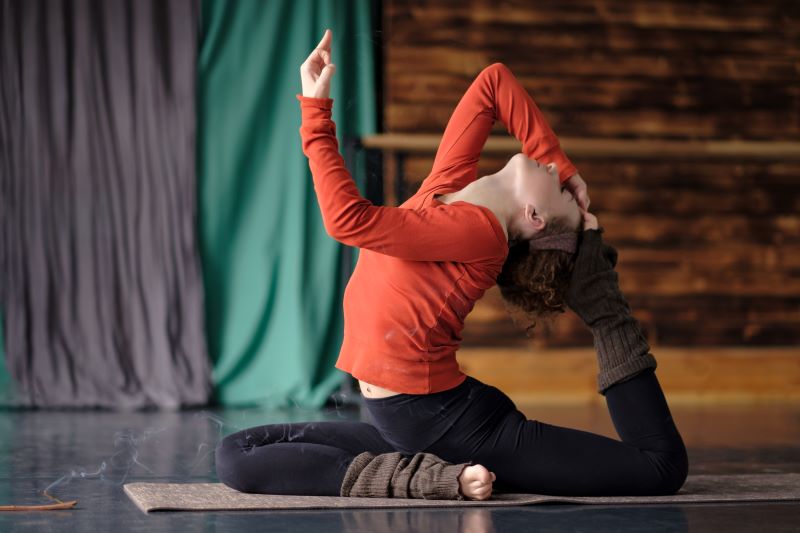
To incorporate Chin Mudra into Eka Pada Rajakapotasana, touch the tips of your thumb and index finger together, forming a circle while extending the other fingers straight. Place your hands on your knees or thighs with the palms facing upwards. Maintain this hand position as you hold the Pigeon Pose, ensuring that your shoulders are relaxed and your spine is aligned.
Benefits of Chin Mudra: Chin Mudra increases awareness and concentration, balances energy levels, and deepens the meditative aspects of the pose.
Types of Eka Pada Rajakapotasana
Eka Pada Rajakapotasana, or One-Legged King Pigeon Pose, has several variations that cater to different levels of flexibility and strength. Here are some types of Eka Pada Rajakapotasana to explore:
1. Half Pigeon Pose
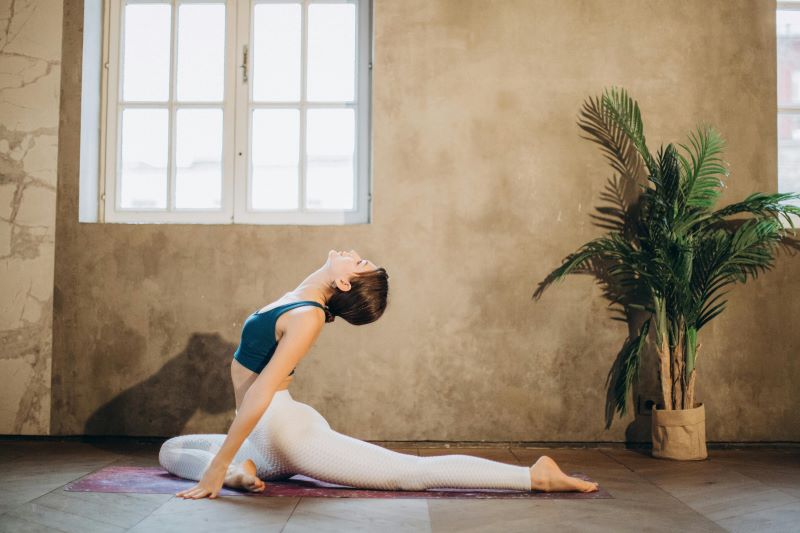
In this variation, the front leg is bent with the shin parallel to the front edge of the mat, and the back leg is extended straight. This version focuses on opening the hip and easing into the full Pigeon Pose, making it suitable for beginners.
2. Sleeping Swan Pose
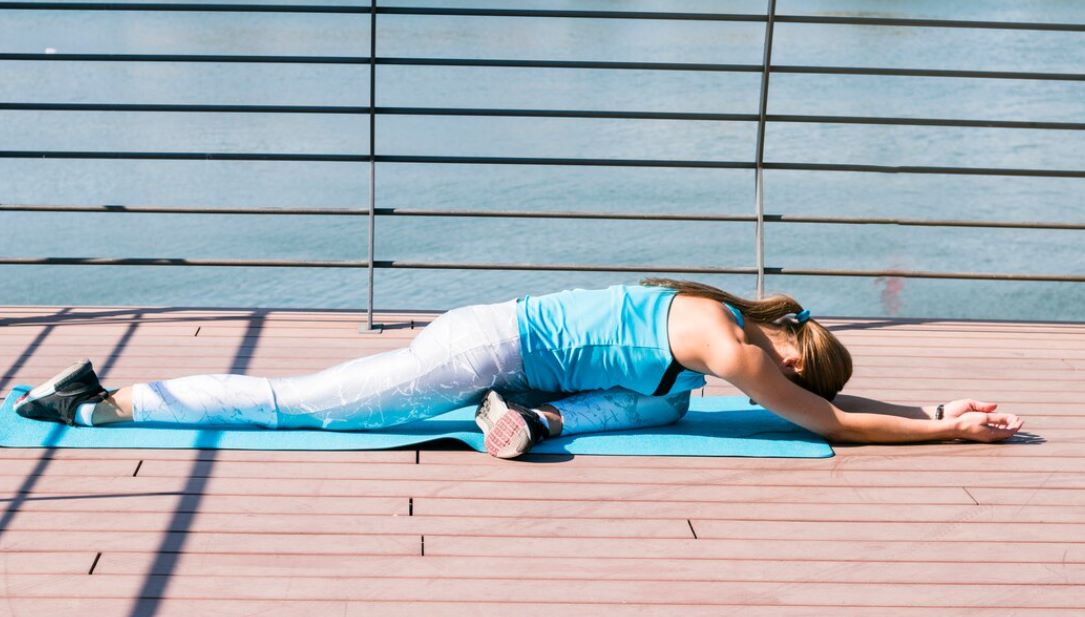
Similar to Half Pigeon Pose, but the torso is lowered to the ground, extending the arms forward or resting the head on the mat. This variation provides a gentle, restorative stretch and is ideal for deep relaxation.
3. Mermaid Pose
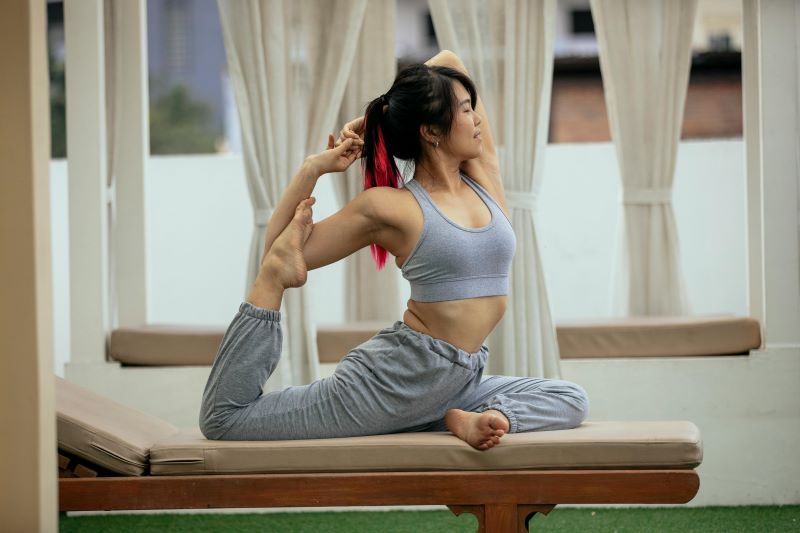
The advanced variation involves bending the back knee and reaching back to grab the foot with one hand, while the other hand reaches over the head to grasp the foot as well. It requires significant flexibility and strength.
Things to Know Before Doing Eka Pada Rajakapotasana
To incorporate Chin Mudra into Eka Pada Rajakapotasana, touch the tips of your thumb and index finger together, forming a circle while extending the other fingers straight. Place your hands on your knees or thighs with the palms facing upwards. Maintain this hand position as you hold the Pigeon Pose, ensuring that your shoulders are relaxed and your spine is aligned.
- Benefits of Chin Mudra: Chin Mudra increases awareness and concentration, balances energy levels, and deepens the meditative aspects of the pose.
Eka Pada Rajakapotasana is a deeply beneficial yoga pose, but it requires careful preparation and awareness. Here are some key points to ensure a safe and effective practice:
- Understand Your Limits: This pose demands significant flexibility and strength, particularly in the hips, legs, and lower back. To avoid injury, recognise your current physical limitations and progress gradually.
- Warm-Up Properly: Warming up is vital before attempting Eka Pada Rajakapotasana to prepare your muscles and joints. Engage in dynamic stretches or sun salutations to increase blood flow and flexibility.
- Use Props for Support: Props like yoga blocks, straps, or cushions can provide essential support, especially for beginners. They help maintain proper alignment and reduce strain on the joints.
- Focus on Alignment: Proper alignment is critical in this pose to avoid unnecessary strain and maximise benefits. Ensure your hips are squared to the front, and your back leg is extended straight.
- Breathe Deeply: Deep, mindful breathing is essential to maintain relaxation and focus during the pose. It helps you stay present and manage any discomfort. Incorporating deep breaths can also enhance the stretch and promote relaxation.
- Practice Gradually: Do not rush into the full expression of Eka Pada Rajakapotasana. Gradually increase the depth of the stretch over time as your flexibility improves. Patience and consistency are key to mastering this pose safely.
- Stay Hydrated: Hydration is important to keep your muscles supple and reduce the risk of cramps. Drink water before and after your practice to stay hydrated. Proper hydration supports overall physical performance and recovery.
- Maintain a Balanced Diet: A balanced diet rich in nutrients supports your overall yoga practice. Foods with antioxidants, vitamins, and minerals can enhance flexibility and strength. Nutrition plays a significant role in maintaining muscle health.
How Long to Sit in Eka Pada Rajakapotasana?
Determining the duration to hold Eka Pada Rajakapotasana depends on your experience and comfort level. Here's a guideline for how long to hold the pose based on different levels of practice:
- Beginners: If you are new to Eka Pada Rajakapotasana, start with holding the pose for 30 seconds to 1 minute. This duration allows you to get accustomed to the stretch without overtraining your muscles.
- Advanced Practitioners: Advanced yogis can hold Eka Pada Rajakapotasana for 3 to 5 minutes or longer, depending on comfort and goals. This extended duration facilitates profound flexibility and emotional release.
Risks of Overdoing Eka Pada Rajakapotasana
While Eka Pada Rajakapotasana offers numerous benefits, overdoing this pose can lead to various risks and injuries. Here are some potential risks of overdoing this yoga pose:
- Hip Strain: Overextending in Eka Pada Rajakapotasana can significantly strain the hip flexors and joints, leading to pain and limited mobility over time.
- Knee Injury: Incorrect alignment or pushing too hard can place undue stress on the knee joint, resulting in pain, inflammation, or even more severe injuries.
- Lower Back Pain: Excessive back bending can lead to lower back pain. This happens when the lower back compensates for a lack of flexibility in the hips.
- Muscle Soreness: Holding the pose for too long can cause muscle soreness. This soreness can hinder your ability to practice and may lead to overuse injuries.
- Joint Overuse: Repeatedly overdoing the pose without proper rest can affect the hips, knees, and lower back, leading to chronic pain and discomfort.
- Hamstring Injury: Excessive stretching of the hamstrings can cause tears or strains. This is particularly risky if you force the back leg too far back.
To mitigate these risks, it's essential to approach Eka Pada Rajakapotasana with patience, proper technique, and awareness. Use props, follow a balanced routine, and listen to your body’s signals to enjoy the benefits of this powerful yoga pose safely.
Important Tips for Practising Eka Pada Rajakapotasana
Eka Pada Rajakapotasana has amazing long-lasting benefits for both your mental and physical health. However, as it is an advanced-level pose, some things need to be known before you start practising it. So, here are some tips for practising this yoga pose:
- Learn Techniques Properly: Before performing this asana, you need to learn the techniques correctly, as one wrong stretch can result in severe injuries to your muscles and limbs.
- Practise a Few Times: Start practising this asana slowly and then gradually increase the repetitions. In the beginning, practising it too many times might result in serious injuries.
- Do Not Outstretch the Limbs: Never outstretch your limbs while performing this asana. In addition, if you feel pain at any point, stop immediately.
- Use Padding for Support: If you are a beginner, you can support yourself with a wall, folded blanket, or yoga block when practising the posture.
- Avoid Sudden Jerks: It is good if you gently release out of the asana, avoiding sudden jerks to your muscles.
What are the Precautions and Contraindications of Eka Pada Rajakapotasana?
Before practising Rajakapotasana, you should be aware of the following precautions and contraindications so as to not adversely affect your body:
If you suffer from chronic back and shoulder pain, injury or slipped disk, you should avoid performing this pose.
Women who are pregnant and menstruating should not perform this asana.
If you have mild to moderate musculoskeletal injuries, talk to your doctor before practising this yoga.
If you have a migraine headache or insomnia, you should avoid doing Kapotasana.
If you are suffering from spondylitis, stiff back, or sore back, it might be better not to practise this posture.
You should avoid performing Rajakapotasana if you are suffering from hypertension.
People with recent knee surgeries or hip, knee, spinal, sacral or abdominal injuries or who have undergone recent hip replacement surgery should avoid practising this asana.
Who Should Avoid Doing Eka Pada Rajakapotasana?
Eka Pada Rajakapotasana is a beneficial yoga pose but may not be suitable for everyone. Certain conditions and physical limitations can make this pose risky. Here are some groups of people who should avoid this pose:
- Individuals with Knee Injuries: Those with knee injuries or knee pain should avoid this pose. The deep bend and pressure on the knee can exacerbate the injury.
- People with Hip Problems: If you have hip injuries or conditions like hip arthritis, this pose can aggravate your condition.
- Those with Lower Back Pain: Individuals suffering from lower back pain should be cautious with this pose. The backbend component can strain the lower back.
- Pregnant Women: Pregnant women should avoid it as the deep stretch and pressure on the abdomen can be uncomfortable and potentially harmful.
- People with Sciatica: Those experiencing sciatica should avoid this pose, as it can irritate the sciatic nerve. The deep hip stretch can cause additional pain.
- Individuals with Ankle or Foot Injuries: This pose can be risky if you have recent or chronic injuries to your ankles or feet.
- Individuals with Certain Medical Conditions: People with certain medical conditions, such as herniated discs or severe osteoporosis, should avoid this pose.
- Those with Shoulder Issues: If you have shoulder injuries or instability, the arm position in this pose can cause discomfort.
What are the Easy Modifications of Eka Pada Rajakapotasana?
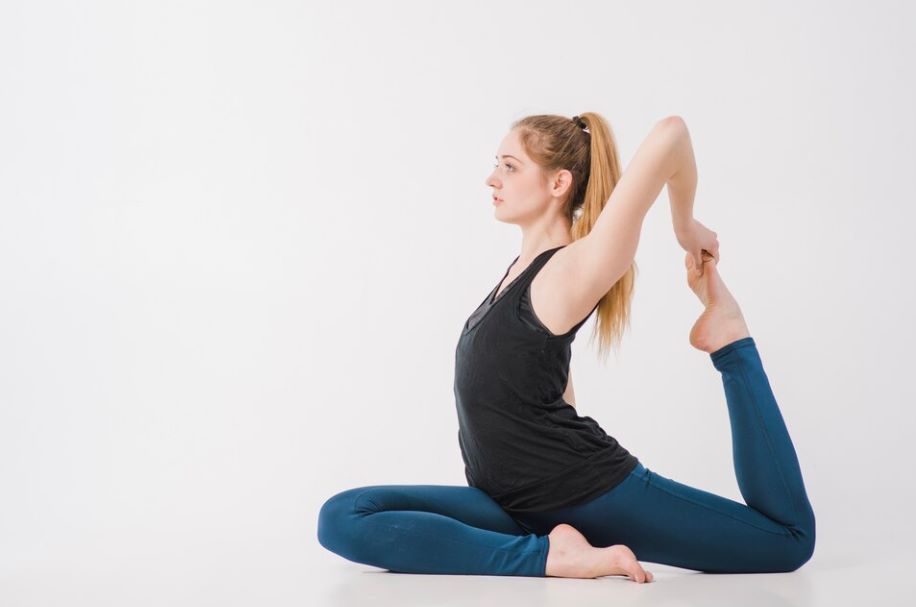
If you are a beginner and finding it tough to perform the Pigeon Pose, you can use the following modifications:
- Use a Pillow or Block: When you have overly tight hips and thighs, it is better if you can use some support under your hip. Using a pillow or block under the hip helps a lot.
- Take the Help of Folded Blanket or Cushion: If you have excessive knee discomfort, you can place a folded blanket or cushion to support the back and knee.
- Use a Strap: If you cannot grasp the back foot with your hands, you can do so with the help of a strap.
- Resting on the Forearm: Those with an underdeveloped core can choose to rest on their forearm for relief. Moreover, with flexibility, one can let one's belly and chest rest on the front leg.
- Changing the Position of the Hands: Change the position of the hand and bring it a little forward, allowing the shoulders to lean towards the hips.
When it comes to yoga, several poses help boost mental, physical, and spiritual health. Furthermore, the health benefits of Pigeon Pose cannot be overlooked, as it is an outstanding yoga pose that you can easily practise at home. All you have to do is learn the steps correctly and keep the precautions in mind.













